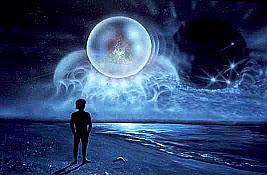

| Online: | |
| Visits: | |
| Stories: |

| Story Views | |
| Now: | |
| Last Hour: | |
| Last 24 Hours: | |
| Total: | |
“A Universe Stranger Than We Can’t Imagine”
Wednesday, March 22, 2017 15:25
% of readers think this story is Fact. Add your two cents.
“A Universe Stranger Than We Can’t Imagine”
By Mark Thompson
By Mark Thompson
“Ever looked up at the night sky and wondered: What is up there? Like your ancestors before you, you would be mistaken if you thought that it’s just the Earth down here and the stars up there. Instead, the night sky encompasses everything that is, or ever was, in the Universe. You see, the really wacky thing about looking up at the sky is that you are not just looking into the depths of space, but also into the depths of time.
Let me explain. Light travels at about 300,000 kilometers per second (186,000 miles per second) – that’s pretty fast. In our day-to-day lives, this doesn’t pose a problem; the light entering my eyes from the display in the coffee shop window takes an immeasurably small period of time to get to me. Basically, I see the display as it is right now.
However, the distances in space are so vast that it takes more time for light to reach us. We see the moon as it was 1.3 seconds ago; the sun as it was 8.3 minutes ago; the nearest star 4.2 years ago; the most distant galaxy as it was about 13.3 billion years ago. The most distant object you can see with your naked eye is the Andromeda Galaxy and even that is about 2.3 million light-years away, which means you see it as it was 2.3 million years ago. Just by looking up, you can see back in time. Crazy.
So all those tiny points of light represent different points in time and that’s how astronomers can build a picture of how the Universe has evolved. But the tiny points of light you see aren’t all just stars, certainly the vast majority is, but turn a telescope to the sky and you will find an entire cosmic zoo of objects just waiting to be explored.
Starting closer to home, our local star, the sun, is about 150 million kilometers (93 million miles) away and the energy generated in its core from the fusion of hydrogen into helium makes life on Earth possible. Moving away from the sun are four tiny rocky planets, Mercury, Venus, Earth and Mars. Interestingly, Mercury isn’t the hottest planet even though it’s closest to the sun; it’s Venus that has the highest temperature. Due to its dense atmosphere, heat that reaches Venus from the sun can’t escape into space. Surface temperatures can reach around 500 degrees Celsius – hot enough to melt lead!
Moving on through the asteroid belt we enter the realms of the gas giant planets: Jupiter, Saturn, Uranus and Neptune, all of which dwarf the Earth. Jupiter itself, the largest of the planets could consume about 1300 Earths and still have a little room for dessert! For the main part, that’s it for the solar system – including a whole host of satellites orbiting the main planets and countless minor planets (including Pluto) and comets.
The nearest star to our own is Proxima Centuari and it lies just over 4 light-years away. Depending on the method of transport, if we were to use today’s technique of gravitational slingshots around other planets, the quickest transit time would be 19,000 years!
If we continue on through the stars, we would be able to see newly-formed clusters of stars and ghostly glowing clouds of gas and dust where stars are either forming or have recently died. Eventually though, after many millions of years, we would pop out of our own galaxy and start a very long haul through the vast empty space between galaxies. Looking back at the Milky Way we would see something that resembled a big spiral of glittering stars. Spiral galaxies like these are quite common in the Universe and look somewhat like two fried eggs stuck back to back; with the yoke representing the bulge at the center of the galaxy and the egg whites, its spiral arms. Surrounding the Milky Way are thousands of spherical globular star clusters containing some of the oldest stars in the Universe.
Moving further away, we find the Milky Way isn’t alone; it’s accompanied by two satellite galaxies called the Magellanic Clouds. Further still, and we are accompanied by millions upon millions of other galaxies in the Universe. Some spiral galaxies like our own, others elliptical in shape more like rugby balls and others just loose clumps of stars with no real defined shape. In-between the galaxies is chiefly just empty space, with some wisps of intergalactic gas and maybe the odd star hurtling into the inky blackness having been gravitationally expelled from a nearby galaxy.
It’s easy to forget when you look up at the sky that there is so much going on above your head. After all, you can just see stars, right? Wrong. As you have just seen, looking up at the sky reveals planets, comets, star clusters, gas clouds and entire galaxies of stars.
I’ve only scratched the surface of the stuff that’s out there, but it reminds me of a quote from Isaac Asimov who once said: “The Universe isn’t stranger than we can imagine, it’s stranger than we can’t imagine.” I’ve not touched on any of the more exotic objects we have discovered but it’s exciting and even tantalizing to wonder what else is lurking out there, just waiting to be discovered.”
- http://news.discovery.com/
Source: http://coyoteprime-runningcauseicantfly.blogspot.com/2017/03/a-universe-stranger-than-we-cant-imagine.html



